Early Office Museum
Historical Office Interior Photographs
~ 1895-1899 ~
When no date is provided in the Description column below, we
do not know the date of the image or photograph.
We have placed undated images and photographs in their likely chronological
order.
If the Source in the right-hand column is anything other than "Early Office
Museum Archives,"
we do not have the ability to grant permission for use or to provide a high
resolution image.
| Click Image to Enlarge | Description | Source |
 |
Office of J. M. Warren & Co., Troy, NY. Joseph Mabbett Warren (1813-96) began in the wholesale hardware business in Troy, NY, in 1840. According to its 1870 catalog, J. M. Warren & Co. sold "tools and supplies for the use of manufacturers, railroads, bridge builders, blacksmiths, engineers, machinists, moulders, tin and sheet iron workers, carpenters, etc." The company sold its goods nationwide at least as late as 1947. The company's building, which dated from 1870, burned and was demolished in the 1970s. The office in the photo has gas lighting. | Early Office Museum Archives |
 |
Office of Roberts Hardware Co., Denver, CO, 1895. On the wall is an 1895 calendar advertising Whitman & Barnes, which manufactured and sold tools during 1848-1915. On the standing desk to the left is an Abbott Automatic Check Perforator, which was introduced in 1889. On the side of the roll-top desk is a flexible speaking tube that connects to a tube in the wall. Roberts Hardware Co. was in business by 1887. | Early Office Museum Archives |
 |
Man and woman in private office, 1895. | Private collection. |
 |
"Grimmestad Land and Loan Office," Belview, Minn., c. 1895. Photograph includes desk phone, seal presses, wall clock, wall safe containing ledgers, kerosene lamp, and stuffed deer head. | Minnesota Historical Society, Neg. No. 13645 |
| Bookkeeping department. Listed by source as c. 1900, but likely to be 1890s. Bookkeeping is being done by writing by hand in ledger books. | Charles
Babbage Institute, Univ. of Minnesota, Minneapolis, Burroughs Corp. Collection, cb000183. |
|
 |
"Office of R. G. Dun & Co. Mercantile Agency," St. Paul, Minnesota, c. 1895. Picture includes a dozen desks with typewriters and male and female typists. Founded as the Mercantile Agency in 1841, R. G. Dun & Co. was the leading U.S. credit reporting agency during the second half of the 19th century. The company also provided other types of commercial information to subscribers. | Minnesota Historical Society, Neg. No. 32566 |
| Marine Department, Fireman's Fund Insurance Co., San Francisco, 1895. The Fireman's Fund was founded in 1863. | Fireman's Fund and J. B. Levison Memorial Collection |
|
| Office, Metropolitan Life Insurance Company, New York, NY, 1896. The Metropolitan Life Insurance Company was founded in 1868 to sell "ordinary" life insurance to middle class workers. In the 1890s, Metropolitan Life's policy holders belonged primarily to the working class. | MetLife Archives | |
| Stenographer taking dictation in an executive's office, Metropolitan Life Insurance Company, New York, NY, 1896. The man is using what appears to be a stepped-drum calculating machine. Near the right side of the photograph is a Centigraph Adding Machine. On the wall is a calendar for September 1896 advertising Ontario Life. There is an electric fan near the calendar and a candlestick phone on the desk. | Early Office Museum Archive |
|
| File Room, U.S. Department of Justice, Washington, DC. These metal filing units were supplied by the Office Specialty Manufacturing Co. The supplier's catalog contains an 1895 testimonial from another buyer, and the supplier's name changed in 1898. As a result, this image dates from close to 1895. | "Metallic Vault and Office Furniture," Office Specialty Mfg. Co., Rochester, NY, c. 1895, in Early Office Museum Archives. | |
 |
Illustration from office furniture advertisement by the Globe Co., Cincinnati, Ohio, 1896. The Globe Co. and the Wernicke Co., another office furniture maker, merged in 1899 to form the Globe-Wernicke Co. | Early Office Museum Archives |
 |
Illustration from office furniture advertisement by the Globe Co., Cincinnati, Ohio, 1896. | Early Office Museum Archives |
Looking North Looking East Looking South |
"Main Office," Home Office Building, National Fire Insurance Co. of Hartford, CT, 1897. These three images show the same large office looking north, east, and south. The National's home office building was completed in 1893. "The main building is three stories in height with a large extension in the rear [to the south], built in one lofty story, containing the Company's main working office and smaller connecting rooms. This office is forty-five feet wide by seventy feet long with a lofty ceiling twenty-four feet high. The walls on the south and west are divided into a series of shallow bays arched above, the lower portion of these bays, or alcoves, being filled with steel cases for documents and records, sufficient to contain all the live records of the Company. Upon the east side of the main office its height is divided by a mezzanine floor, giving below suitable offices for the secretary, stenographers, and for supplies, and above a gallery for special agents' desks." To the right of the center of the middle image (looking east) is what appears to be a built-in vertical file cabinet. If so, this is the earliest image we have found of a vertical file cabinet. However, because the vertical file cabinet was not introduced until 1893, this may be something else. | National Fire Insurance Co of Hartford, A Quarter-Century's Fire Underwriting, 1981-1896: An Historical and Biographical Milestone in the Life of the National Fire Insurance Co. of Hartford, Conn., 1897, in Early Office Museum Archives. |
| "Stenographers' Office," Home Office Building, National Fire Insurance Co. of Hartford, CT, 1897. The middle image immediately above shows the main office looking east. Near the middle of that image is an open door that leads to the stenographers' office. The image to the left shows that the stenographers' office contained three desks, a typewriter stand, devices to hold long sheets of paper (presumably used to record dictation in shorthand), and four typewriters. The typewriters included a Smith Premier No. 2 (left), a Remington Standard No. 6 (right of center), and a Caligraph with a wide carriage (right). These Smith Premier and Remington models were introduced in 1896 and 1894, respectively. Images of the various company offices reveal only a limited range of office machinery. A number of desks had telephones, inkwells, paperweights, and letter trays. There was a seal press, a Bates (or similar) numbering machine, and a postal scale, and there were a few small desktop devices that are not sufficiently clear to permit identification. | National Fire Insurance Co of Hartford, Same as preceding image. | |
 |
"Hon. W. S. Hammond in Office at St. James," St. James, Minn., photograph by Ernest T. Graver, 1897. Photograph shows a stenographer using a Smith Premier No. 1 typewriter (introduced in 1889), wall telephone, and safe. | Minnesota Historical Society, Neg. No. 5232 |
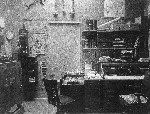 |
Office with Smith Premier typewriter, safe, and wall telephone. | Available from Ron Beck www.centuryimages.com |
 |
Norfolk and Western Railway office, c. 1897. The Norfolk and Western Railroad Co. was the result of a reorganization of a number of existing railroads in 1881. The company was renamed the Norfolk and Western Railway Co. in 1896. The telephone on the wall is an 1882 vintage American Bell Telephone Co. phone manufactured by Western Electric Co. at its Chicago factory and referred to as a Chicago #2 bell with Blake transmitter. (Identification by Tom Adams.) Image includes picture of President William McKinley (1897-1901), letter copying press, potbelly stove, and kerosene lamp. | Virginia Tech ImageBase, Norfolk & Western Hist. Photo. Coll., ID: nw3787 |

|
Norfolk and Western Railway office. Picture includes Remington typewriter, rubber stamp rack, and electric lighting. | Virginia Tech ImageBase, Norfolk & Western Hist. Photo. Coll., ID: nw3845 |
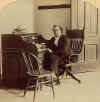 |
"William Jennings Bryan in His Recruiting Office," stereoview published by Strohmeyer & Wyman, New York, NY, 1898. Bryan was the Democratic presidential nominee in 1896, 1900, and 1908. | Early Office Museum Archives |
 |
Auditors Office, Reproduction Bureau, New York Telephone Co., New York, NY, 1898. | Private collection |
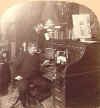  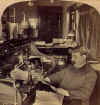 |
Stereographs of the same man and office published by three companies: C. H. Graves, Philadelphia, PA, top; Geo. W Griffith, Philadelphia, PA, middle; and Strohmeyer & Wyman, New York, NY. The first of the three images to the left shows a copy of the War Department Telegraphic Code (center) and a poster entitled "Ships of the US Navy" (top right). These items suggest that the office was in the Department of the Navy, Washington, DC. The three companies that published these stereographs also published stereographs of naval ships during the Spanish-American war. The first image shows that the office had telegraph equipment and four telephones. The other photographs show that the office had an upstrike typewriter. | Early Office Museum Archives |
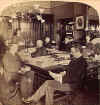 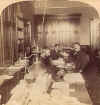 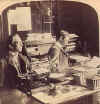 |
Three stereographs of offices by Strohmeyer & Wyman, New York, NY. Based on the stereograph above by Strohmeyer & Wyman, which is identical in format, these three stereographs may show offices in the Department of the Navy, Washington, DC. Office items visible in these photographs include upstrike typewriters, a pen and inkstand, a paperweight, letter trays, and a board clip (that is, a clip board). The man sitting center rear in the middle photo is African American | Early Office Museum Archives |
| "Private Office of Cyrus Field Adams, Successful
Business Man and Publisher of 'The Appeal,' Chicago, Ill.," very late
1890s. The Appeal was an African American newspaper founded in
1885. The
African American Registry states that "the 'Appeal' became one of
the leading Afro-American newspapers in the nation. At its high point in
the 1880’s, it was published in Dallas, Washington, D.C., St. Louis,
Louisville, and Chicago. By December 1888, the 'Chicago Appeal,' under the
editorship of Cyrus F. Adams, became the most read black newspaper in that
city. The hey-day of the 'Appeal' would decline by 1901.” The College of Life (p. 20) states that "At the present time there are over 200 journals and magazines published by the colored people of the country." This book, which was copyrighted in 189_ (last digit not printed) appears to have been written in the very late 1890s. The back of our copy includes tables with 1900 Census data; perhaps these pages were added to later printings. |
Henry Davenport Northrup et al., The College of Life or Practical Self-Educator, A Manual of Self-Improvement for The Colored Race, 189X, p. 116, in Early Office Museum Archives. | |
 |
"The Local Forecast Office," National Weather Service, Buffalo, NY, 1899. The U. S. national weather service was set up in 1870. Picture includes typewriter and electric lighting. | NOAA Photo Library, Historic NWS Coll., ID: wea01304 |

|
"Office of Deere and Company," Minneapolis, Minn., dated by Minnesota Historical Society as 1890 but probably closer to 1900. John Deere began producing steel plows in 1837. Deere & Co. was incorporated in 1868. It made steel plows, and by 1907 it was also making cultivators, corn and cotton planters, and other implements. Picture shows a woman at a Remington upstrike typewriter, candlestick telephone, and electric lighting. | Minnesota Historical Society, Neg. No. 17219 |
| Click on link at right to see photo. When finished, click the "Back" button on your browser to return here. | Office of W. L. Prather, President of the University of Texas at Austin, 1899-1905. Photograph shows a Wooton Patent Cabinet Office Secretary, probably produced by the Wooton Desk Co., Indianapolis, IN, between 1874 and 1884, although possibly produced as late as 1897 by a purchaser of the Wooton patent rights. | Center for American History, University of Texas at Austin, cn09380 |
 |
Office with two men. There is a kerosene lamp, a safe, and a rolltop desk. | Private collection |
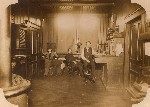 |
Office with a boy and two men. There are kerosene lamps and a letter copying press. There is no evidence of electric lighting. | Early Office Museum Archives |
 |
Office with Wooton cabinet office secretary. There is electric lighting and a candlestick phone. Lower image is a detail from the top image. | Early Office Museum Archives |
| Click on link at right to see photo. When finished, click the "Back" button on your browser to return here. | Office with three men in the Smithsonian Institution Building, Washington, D.C. There is a letter copying press in the back of the image. | Smithsonian Institution Archive |
 |
Small office in New York City. Notice the filing technologies. | Early Office Museum Archives* |
 |
Office with man, numerous small filing cabinets and boxes, a postal scale, and gas lighting. Boxes in the upper left corner are labeled "Foreign Invoices: J.E.R" and "Domestic Invoices, Sundries: J.E.R." J.E.R. may stand for Jersey Eastern Railway, which operated from 1873 to 1929 on Jersey, an island in the English Channel. | Early Office Museum Archives |
 |
Office with 3 men and 1 woman, by Commercial Photo Co., Boston, MA. The only other photo by the same photographer that we found on the internet was dated 1896. | Early Office Museum Archives |
 |
William E. Burtis in his office, by The Empire Illustrating Co., New York, NY. A book has "Siegel Cooper" printed across the page edges. Siegel Cooper & Co. was a Chicago department store company from 1887 until 1913. In 1896, it opened an opulent store in NYC that it claimed was the largest store in the world. In the foreground on the desk is a Security Check Protector, which was patented in 1879 and advertised between 1879 and c. 1899. | Early Office Museum Archives |
 |
Law Library, Buchanan & Lawyer, Albany, NY, glass lantern slide, 1898. Charles Jay Buchanan and George Lawyer formed this law firm in 1897. In 1900, the firm became Buchanan, Lawyer & Whalen. Buchanan (1843-1916) enlisted in the Union Army in 1861 and was a member of the famous Bordan's sharpshooters until the end of the Civil War. He participated in 43 battles and skirmishes from Yorktown in 1862 to Appomattox in 1865 and was never wounded. From 1910 to 1916, Buchanan was associated as counsel with the firm of Visscher, Whalen & Austin. | Early Office Museum Archives |
 |
Office, 1899. This office has a Shannon Filing Cabinet on the left; this type of cabinet was typically used to file letters. Moving from left to right, the similarity of the first two men suggests they were brothers. The right leg of the seated man is about 8" shorter than his left leg, and an attachment to his right shoe makes up the difference. On top of the desk in the center of the photo are three lion head seal presses and a McGill Single Stroke Staple Press. An upstrike typewriter is on the roll-top desk on the right. Photo dated by wall calendar. | Early Office Museum Archives |
  |
Two offices at The Detroit
News, Detroit, MI. The Detroit News began publication in
1873 and as of 2010 was still being published.
The top photo is identified as the Business Office of the
newspaper. This photo is undated. |
Early Office Museum Archives |
 |
Office with six men and a boy. Two of the men have long handlebar moustaches and two have wing tip collars. | Early Office Museum Archives |
  |
Two offices at Postal, Telegraph & Telephone Service. Top photo is labeled "Lady Clerks Returning ..... to Senders, Dead Letter and Parcel Office." | Early Office Museum Archives |
| Office, W. H. Comstock,
Morristown, NY, manufacturer of Dr. Morse's Indian Root Pills. This card
evidently dates from the late 1910s, but the image appears to show a late
19th century office interior. According to Wikipedia: "Dr. Morse's Indian Root Pills have their genesis in William Henry Comstock's father, Edwin P. Comstock, who founded a drug company in New York City in 1833. The Comstock patent medicine business was involved in the sale of a number of successful drugs, including Carlton's Pile Liniment, Oldridge's Balm of Columbia, Kline's Tooth Ache Drops and Judson's Worm Tea. ... The Indian Root Pills were first formulated and manufactured in 1854 by Andrew B. Moore. Ownership of Dr. Morse's Indian Root Pills ... in 1867 ... settled ... in the hands of William Henry Comstock, and thereafter business was carried out under the name W. H. Comstock Co. Ltd. When William Henry Comstock died in 1919, control of the company passed to his son, William Henry Comstock II ... William Henry Comstock II died in 1960, and W. H. Comstock Co. Ltd. ceased operations a year later, patent medicines having already been in decline." The back of the card states: "For more than sixty years the Morse's Indian Root Pills have been before the public." Because the pills were introduced in 1854, the card apparently dates from the late 1910s. |
Early Office Museum Archives |
Photographs are copyrighted. All rights are reserved by the copyright holder, the owner of the photograph, and the Early Office Museum.